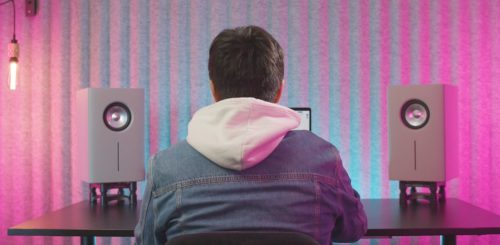
How To Teach Students Drum Patterns Through Soundtrap for Education
October 14, 2022Let’s face it; many students love making loud noises, experimenting with rhythms, and creating unique dances. You might even have a few students that intuitively make their own beats by tapping on their desks in class. So, why not encourage your students to channel this creative energy into real music by creating drum patterns?
When students understand drum patterns, they can create cohesive beats. Beats are the foundation of most songs that your students know and love. Today’s cloud-based DAWs make it easier for students of all ages to experiment with sound and understand drum patterns through hands-on lesson plans. These simple tips will help you teach students all about drum patterns, beat-making, and audio production in a safe digital environment.
First Off, What Is a “Drum Pattern?”
Drum patterns, also known as “drum programming,” are an integral component of making electronic music, particularly when it comes to beat-making. Modern DAWs allow students of all ages to experiment with their ideas with built-in drum plugins. Additionally, the intuitive user interface allows users to see each beat’s pattern, change the samples, or arrange and edit the track.
Drums patterns open up a new world of possibilities for students because they rely on the power of rhythm to create an engaging sound. When students learn about drum patterns, they will begin to understand how rhythm carries every component of a track and gives students the ability to tell a story through song.
Here’s Why Students Are Making Digital Music
Recent data shows that creating music fosters a greater sense of discipline, improves motor skills, and increases attention to detail. However, just a few years ago, students could only participate in music-making if they took ensemble music classes.
Additionally, traditional music classes are intrinsically exclusionary to students that don’t have access to band instruments or knowledge about music theory. Moreover, elementary-aged students and students with movement impairments may not be able to play traditional music.
However, when educators bring digital music into the classroom, it allows every student to participate and express themselves in a new way. Most of the music that students enjoy is created with the same digital tools, music technology in the classroom allows students to view the music creation process through a familiar lens.
Today’s students consider technology a natural and essential part of their everyday lives. Most students use smartphones, laptops, and other wifi-connected devices at all hours of the day. Giving them access to DAWs and music-making through these devices increases the likelihood of adherence to a music program.
Teach Your Students How to Use Drum Patterns
Encouraging students to create their own beats and use drum patterns allows them to think about music composition, rhythm, and time in new ways. Students that aren’t drummers may initially believe that creating drum beats is too complicated. However, education-based DAWs make it easy for anyone to learn. With Soundtrap for Education, teaching your students to create their own beats and incorporate drum patterns into original songs is as easy as these simple steps.
1.Define the Lesson Plan’s Objective
Creating a space where all students can experiment with beat-making and drum patterns teaches your students to listen to drums differently. Since the average music listener has no idea how drummers establish rhythms and create grooves, you’ll need to define your lesson plan’s objective.
If the objective of your lesson is to learn the basic principles, you can start by encouraging your students to identify the rhythm and time of each drum beat’s pattern. Your students can explore the snare, hi-hat, and other types of drums. Teaching your students about different measure patterns gives them first-hand knowledge about how various song elements can work together.
This exercise demonstrates how basic rhythmic patterns only sound complex because they are layered over one another. It may also be helpful to teach your students basic drum notation if it suits your lesson plan. Even if your students aren’t learning to drum with traditional instruments, seeing basic drum notation can help students understand drum patterns better when it’s time to create their song.
Remember, defining your lesson plan is the first step. Understand the types of students you’ll be working with, and a modern DAW can give you the necessary tools to teach your students from anywhere, at any time.
2. Let Students Create Their Own Drum Beats
Since the drum pattern sets the tone for the entire track, it’s an excellent place for students to start. Drum patterns make it easy for students to experiment with different beats and work out the rest of the song. If you’re using Soundtrap, you can allow your students to access the Patterns Beatmaker by adding a new track and selecting “Drums and Beats.” Once students open the Patterns Beatmaker, they can choose the Drum Machine or Drum Kit to start.
Each student will see rows of boxes within the Patterns Beatmaker, so they can easily visualize each loop and beat. Now for the fun part! Students can start experimenting with different patterns and BPMs at the touch of a button.
Many students absorb musical concepts much better with the help of engaging, hands-on activities. If your students are elementary-aged or new to the world of music, encourage them to create beats with the “Instrument Mode” within the Patterns Beatmaker. Here, students can use their computer keys, like visual drums, to make their beat and engage with learning materials in a new way.
3. Teach Students to Create Their Bass Line and Melody
Casual music listeners typically don’t realize the function of a bassline within their favorite songs. The bassline creates a tonality and ties the other components of the song together. Electronic basslines vary greatly depending on the genre of music, and making these basslines from scratch is quite complicated. However, Soundtrap has plenty of built-in bass loops. Even students with limited experience can create a professional-sounding project.
Once your students have a solid foundation, they can establish the song’s melody. Just like drum patterns, the best melodies are simple. The right melody can turn a lackluster song into a memorable masterpiece. While teaching students about bass line and melody, it is a great time to teach your students about the components of catchy melody. This includes repetition, variation, call and response, and performance. The more they understand all of the elements of the music-making process, the higher the likelihood that they’ll continue in their music journey.
4. Incorporate Embellishments and Expand the Beat
At this point, your students’ creations will begin to sound like actual songs. However, there is often a sense of emptiness within songs lacking depth. Students can learn to “fill in the gaps” for a bold, full sound. Although these embellishments aren’t required, they add a new level of sonic interest to the music. Encourage your students to experiment with thousands of sound effects in Soundtrap’s Loop Library to perfect the song’s overall sound.
Once each song component is in the right place, students can move different track elements around and create variation while the core beat remains the same. During this step, students will learn more about musical transitions. Then, they can leatn how to create a song that keeps listeners engaged without sounding repetitive or boring.
5. Mix and Master the Beat
Now, your students can fulfill their creative vision by mixing and mastering their unique tracks. Since students have been working on their songs for quite a while, encourage them to share their songs and collaborate within this cloud-based platform. They can gain a perspective from a fresh set of ears. Making music is a collaborative process that’s all about connecting with others. When students are encouraged to share their musical creations with each other, it cultivates a sense of community that fosters unbridled creativity.
Audio mixing and mastering are often confused with one another. However, they’re actually complementary steps. Audio mixing involves balancing levels, audio panning, compression, reverb, and other effects and comes right before mastering.
Audio mastering is the final step in audio production. It gives a mix a cleaner sound ready for streaming, removing the rough harshness in frequencies and any distortions in the music.
Although most DAWs require music makers to master music themselves, the Soundtrap Studio automatically masters music as soon as you hit “save.” With Soundtrap for Education, your students can tap into their creative side, collaborate, and allow their voices to be heard.
Why Soundtrap For Education?
Soundtrap for Education is the ultimate audio production platform for students and teachers to create and edit audio recordings. This innovative platform provides users with automatic transcription tools, interactive editing, and the ability to upload projects directly to Spotify. Students and teachers can easily tap into their artistic side with this intuitive audio platform. They can facilitate a creative learning environment regardless of the student’s age or experience level.
With Soundtrap for Education, students and teacher collaborate through advanced cloud technology at any time or place. In addition, the platform comes equipped with a robust resource portal. The portal contains tutorials, an external curriculum, and lesson plans to complete the educational experience. Finally, teachers ensure that student collaboration is safe and secure with invite-only groups in Soundtrap’s versatile digital environment.
 EDU Portal
EDU Portal


